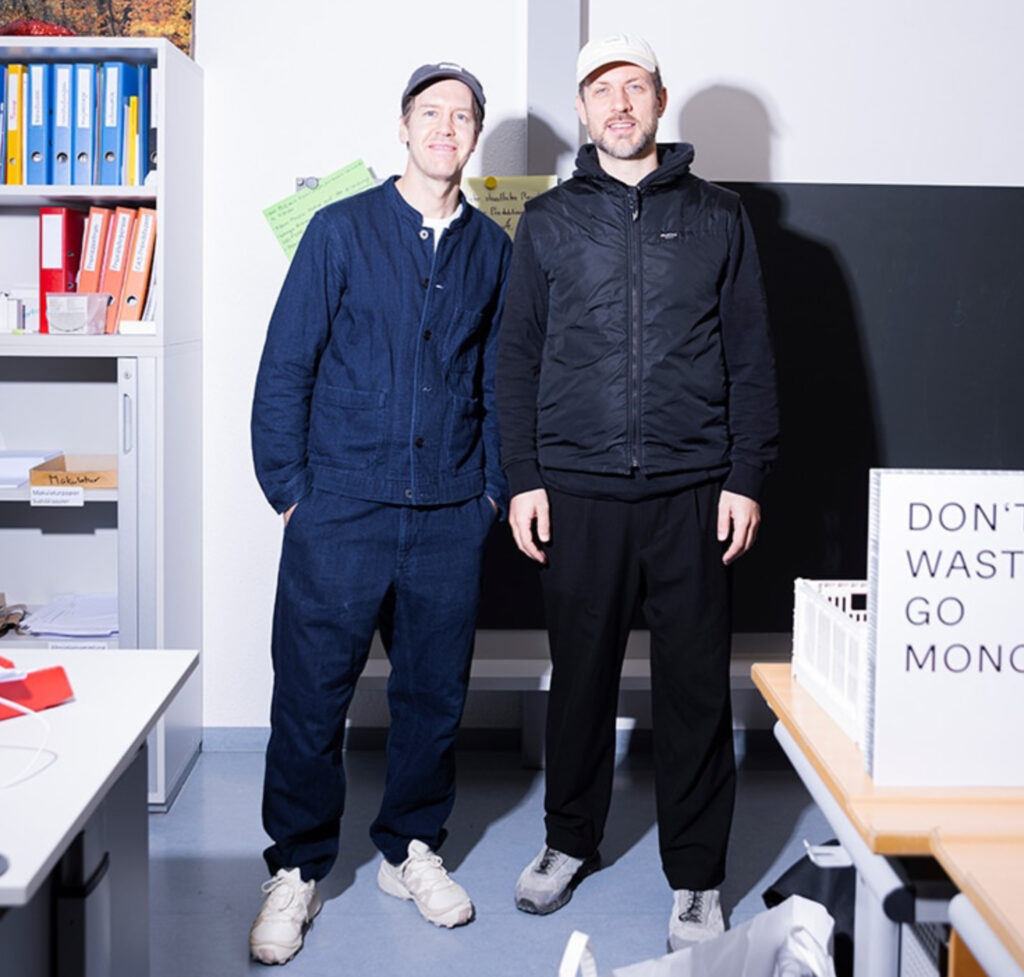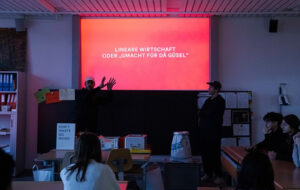In the world of Formula 1, few names command the reverence and humility quite like Sebastian Vettel. A four-time world champion, Vettel is often associated with speed, precision, and competition. But post-retirement, his trajectory has taken an altogether quieter — though no less ambitious — turn. Swapping asphalt circuits for the classroom and podiums for school desks, Vettel has become an increasingly vocal advocate for sustainability, using his influence to steer public attention toward climate consciousness and ethical responsibility. His latest venture — a connection with Swiss eco-fashion brand Neumühle — is not just another celebrity endorsement. It’s a pedagogical experiment, a cultural intervention, and a vision for the future of fashion education.
Earlier this year, Vettel joined Neumühle in delivering a hands-on lesson about circular fashion at a school in Switzerland. The subject was not just clothing or consumption, but circularity — a radical design philosophy that seeks to eliminate waste by keeping materials in use through reuse, repair, and recycling. While the concept of a circular economy has been buzzing in environmental circles for years, its presence in classrooms, especially in tandem with high-profile public figures, remains rare. That rarity made the Vettel-Neumühle collaboration not only symbolic but deeply instructive. The message was clear: a shift in culture begins with a shift in curriculum.
From Track to Textile: A Driver’s Evolution
For fans who grew up watching Vettel battle the likes of Lewis Hamilton or Fernando Alonso, the idea of him folding fabric or discussing compostable fibers might seem jarring. But in truth, the seeds of his environmental awakening were sown during his final years in F1. As the motorsport industry came under increasing scrutiny for its carbon footprint, Vettel began to speak out. He launched initiatives around biodiversity, visited bee farms, and once cleaned the grandstands at Silverstone to set an example for waste consciousness.
So when Neumühle — a Zurich-based brand committed to circular design — approached him, it felt less like a marketing ploy and more like a logical extension of his mission. Neumühle, which has built its reputation on using regenerative materials and operating a traceable, low-impact supply chain, found in Vettel a collaborator who understood that performance and principle need not be mutually exclusive. Together, they brought a tailored sustainability curriculum into a school environment, targeting not just how we wear clothes, but how we think about them.
Circularity 101: A Lesson in Loops
The lesson delivered at the school wasn’t theoretical. Students were invited to deconstruct garments, examine fabric labels, and trace the lifecycle of everyday clothing items. Under Vettel’s guidance — who traded his fireproof racing suit for a utilitarian Neumühle jacket — students learned how traditional fashion systems rely on linear production: make, use, discard. In contrast, circular fashion imagines a looped system, where waste is designed out from the beginning.
They studied natural fibers like Tencel, hemp, and organic cotton. They debated the feasibility of recycling synthetic textiles. And they even examined garments from their own wardrobes, dissecting stitching and identifying whether zippers or dyes would inhibit recyclability. Neumühle’s educators complemented the session with live demonstrations — showcasing how modular design can allow garments to be easily disassembled and remade.
But more than the tactile lessons, what stood out was the gravity of Vettel’s involvement. His presence brought weight to the message — not in the sense of star power, but through humility. He wasn’t there to lecture but to learn alongside. He asked questions. He listened. For a classroom of teenagers conditioned to see celebrities as remote icons, the image of a Formula 1 champion earnestly pondering the water usage of cotton production was transformative.
Neumühle: A Swiss Brand Rewriting the Fashion Script
To understand the full impact of this event, one must consider Neumühle’s distinct approach to fashion. Founded in Switzerland and inspired by both Alpine durability and Bauhaus minimalism, the brand has made circularity its core ethos. Every Neumühle garment is produced using responsibly sourced materials, and the company emphasizes end-of-life solutions such as return programs, biodegradable packaging, and garments engineered for disassembly.
Their collections are sparse, intentional, and anti-trend. The color palette is subdued, often composed of earth tones, fog greys, and natural undyed fabrics. The silhouettes are androgynous and practical — workwear-inspired but devoid of gimmickry. Rather than overwhelming consumers with choice, Neumühle focuses on education: issuing transparency reports, sustainability guides, and now, apparently, school visits.
Their partnership with Vettel isn’t commercial — there’s no capsule collection, no promotional stunt. It is, instead, a shared belief in the cultural work of sustainability. And perhaps that’s what makes it so potent. Rather than preaching to the converted, Neumühle and Vettel took their message where it’s most urgently needed: the formative spaces where values are still being shaped.
Why Fashion Belongs in the Classroom
The inclusion of circular fashion into school curricula is not just a novelty — it’s a necessity. The fashion industry is the third-largest polluter globally, accounting for around 10% of annual carbon emissions and 20% of wastewater. Fast fashion companies churn out endless collections with planned obsolescence built into their business models. Meanwhile, landfills overflow with synthetic fibers that won’t biodegrade for centuries.
Yet despite these facts, fashion remains absent from most educational frameworks. Students learn about photosynthesis, Newtonian physics, and even trigonometry — but rarely are they taught to interrogate the labels on their own clothes. In failing to integrate material literacy into our pedagogy, we perpetuate a system in which ignorance sustains exploitation.
By introducing fashion through the lens of circularity, the Vettel-Neumühle initiative reframes it not as an indulgence, but as an urgent civic responsibility. Students are no longer just consumers — they are stakeholders in a global textile economy. And they deserve the tools to navigate it ethically.
The Emotional Torque of Personal Engagement
There was another layer to Vettel’s presence in the classroom that deserves mention — the emotional torque of a hero turned human. In a media landscape oversaturated with filters, edits, and marketable personas, the act of a global sports icon kneeling beside a student to inspect the grain of a recycled jacket speaks volumes.
The psychological power of this engagement is real. Educational theorists have long emphasized the importance of role models in shaping student motivation. When a public figure like Vettel champions environmental responsibility not with rhetoric but with embodied action, the abstract becomes personal. The lesson isn’t just about textiles; it’s about agency.
This approach also punctures the myth that sustainability is elitist. Too often, ethical fashion is framed as the domain of the privileged — people who can afford to care. By entering a public school with a philosophy of humility and inclusion, Vettel and Neumühle redefine sustainability as a democratic value. The goal is not perfection, but participation.
The Road Ahead: Beyond One-Off Lessons
Of course, one lesson — no matter how impactful — cannot transform the system. The question, then, is how to scale this model. What if every fashion brand adopted a school? What if environmental literacy became a national curriculum standard? What if celebrities took on ambassadorial roles, not just for products, but for principles?
There are already glimmers of such a shift. Initiatives like Fashion Revolution’s #WhoMadeMyClothes campaign and The Ellen MacArthur Foundation’s circular design programs are pushing for broader awareness. But what Vettel and Neumühle demonstrated was the power of intimacy — of showing up, physically, and investing time in dialogue. The fashion world is full of high-budget campaigns and abstract commitments. This was different. This was eye-level activism.
In the months following the visit, the school reportedly began integrating sustainability topics across disciplines — linking fashion to chemistry (dye toxicity), economics (labor and production costs), and even art (textile design). Teachers noted an increase in student curiosity, with several expressing interest in studying design, engineering, or environmental science.
In that sense, the lesson continues — not as a single event, but as a seed planted in soil. A student may now look at their closet and wonder, “What is this made of? Who made it? Where will it go when I’m done?” And from those questions, new designers, thinkers, and citizens may emerge.
Impression
Sebastian Vettel could have easily stepped away from public life after F1, basking in his legacy and lucrative endorsements. But instead, he chose to confront the most urgent crisis of our time. By aligning with Neumühle and embedding himself in the microcosm of a classroom, he expanded the very definition of influence.
Fashion, too, must now expand its definitions — of success, of beauty, of responsibility. Circularity is not just a design framework; it is a cultural reorientation. It asks us to resist the fast, the disposable, the easy — and to embrace slowness, repair, and reciprocity.
In the Neumühle school visit, we saw what this reorientation can look like in action: a racer turned educator, a brand turned community partner, a classroom turned crucible for new thinking. It was not a campaign. It was not a performance. It was the beginning of a new loop — one that doesn’t end in a landfill, but in possibility.
No comments yet.









